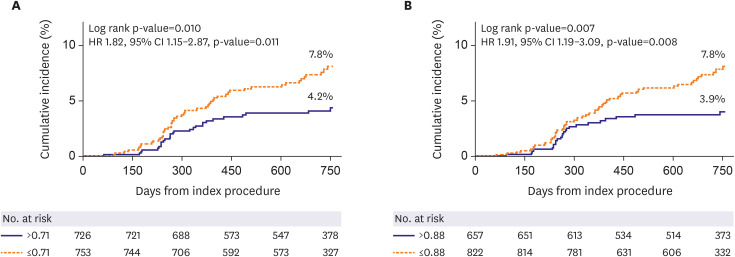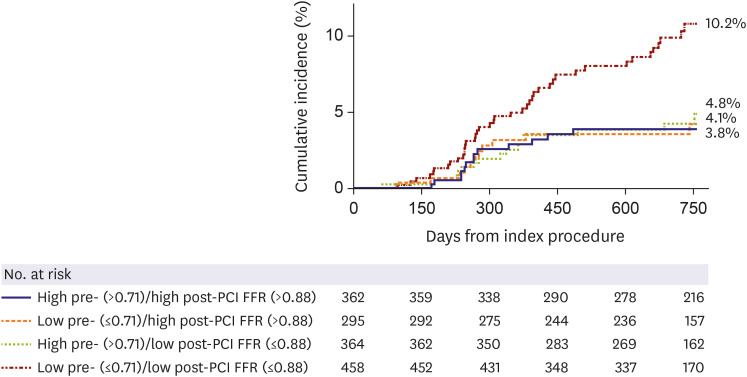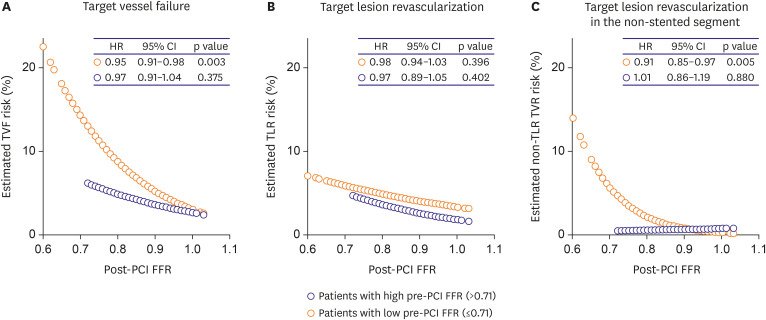Korean Circ J.
2022 Jan;52(1):47-59. 10.4070/kcj.2021.0128.
Differential Prognostic Implications of Pre- and Post-Stent Fractional Flow Reserve in Patients Undergoing Percutaneous Coronary Intervention
- Affiliations
-
- 1Department of Cardiology, The Second Affiliated Hospital Zhejiang University School of Medicine, Hangzhou, China
- 2Department of Internal Medicine and Cardiovascular Center, Seoul National University Hospital, Seoul, Korea
- 3Cardiovascular Center, Dongguk University Ilsan Hospital, Goyang, Korea
- 4Division of Cardiology, Department of Internal Medicine, Heart Vascular Stroke Institute, Samsung Medical Center, Sungkyunkwan University School of Medicine, Seoul, Korea
- 5Department of Cardiology, Keimyung University Dongsan Medical Center, Daegu, Korea
- 6Division of Cardiology, Ulsan Hospital, Ulsan, Korea
- 7Department of Cardiology, Inje University Ilsan Paik Hospital, Goyang, Korea
- 8Division of Cardiovascular Medicine, Tsuchiura Kyodo General Hospital, Tsuchiura, Japan
- 9Division of Cardiology, Nanjing First Hospital, Nanjing Medical University, Nanjing, China
- KMID: 2524169
- DOI: http://doi.org/10.4070/kcj.2021.0128
Abstract
- Background and Objectives
The influence of pre-intervention coronary physiologic status on outcomes post percutaneous coronary intervention (PCI) is not well known. We sought to investigate the prognostic implications of pre-PCI fractional flow reserve (FFR) combined with post-PCI FFR.
Methods
A total of 1,479 PCI patients with pre-and post-PCI FFR data were analyzed. The patients were classified according to the median values of pre-PCI FFR (0.71) and post-PCI FFR (0.88). The primary outcome was target vessel failure (TVF) at 2 years.
Results
The risk of TVF was higher in the low pre-PCI FFR group than in the high pre-PCI FFR group (hazard ratio, 1.82; 95% confidence interval, 1.15–2.87; p=0.011). In 4 group comparisons, the cumulative incidences of TVF at 2 years were 3.8%, 4.1%, 4.8%, and 10.2% in the high pre-/high post-, low pre-/high post-, high pre-/low post-, and low pre-/low post-PCI FFR groups, respectively. The risk of TVF was the highest in the low pre-/low post-PCI FFR group among the groups (p values for comparisons <0.05). In addition, the high pre-/low post-PCI FFR group presented a comparable risk of TVF with the high post-PCI FFR groups (p values for comparison >0.05). When the prognostic value of the post-PCI FFR was evaluated according to the pre-PCI FFR, the risk of TVF significantly decreased with an increase in postPCI FFR in the low pre-PCI FFR group, but not in the high pre-PCI FFR group.
Conclusions
Pre-PCI FFR was associated with clinical outcomes after PCI, and the prognostic value of post-PCI FFR differed according to the pre-PCI FFR.
Figure
Reference
-
1. Shaw LJ, Berman DS, Maron DJ, et al. Optimal medical therapy with or without percutaneous coronary intervention to reduce ischemic burden: results from the Clinical Outcomes Utilizing Revascularization and Aggressive Drug Evaluation (COURAGE) trial nuclear substudy. Circulation. 2008; 117:1283–1291. PMID: 18268144.2. Neumann FJ, Sousa-Uva M, Ahlsson A, et al. 2018 ESC/EACTS guidelines on myocardial revascularization. Eur Heart J. 2019; 40:87–165. PMID: 30165437.3. Patel MR, Calhoon JH, Dehmer GJ, et al. ACC/AATS/AHA/ASE/ASNC/SCAI/SCCT/STS 2017 appropriate use criteria for coronary revascularization in patients with stable ischemic heart disease: a report of the American College of Cardiology Appropriate Use Criteria Task Force, American Association for Thoracic Surgery, American Heart Association, American Society of Echocardiography, American Society of Nuclear Cardiology, Society for Cardiovascular Angiography and Interventions, Society of Cardiovascular Computed Tomography, and Society of Thoracic Surgeons. J Am Coll Cardiol. 2017; 69:2212–2241. PMID: 28291663.4. van Nunen LX, Zimmermann FM, Tonino PA, et al. Fractional flow reserve versus angiography for guidance of PCI in patients with multivessel coronary artery disease (FAME): 5-year follow-up of a randomised controlled trial. Lancet. 2015; 386:1853–1860. PMID: 26333474.
Article5. Zimmermann FM, Ferrara A, Johnson NP, et al. Deferral vs. performance of percutaneous coronary intervention of functionally non-significant coronary stenosis: 15-year follow-up of the DEFER trial. Eur Heart J. 2015; 36:3182–3188. PMID: 26400825.
Article6. Xaplanteris P, Fournier S, Pijls NHJ, et al. Five-year outcomes with PCI guided by fractional flow reserve. N Engl J Med. 2018; 379:250–259. PMID: 29785878.
Article7. Parikh RV, Liu G, Plomondon ME, et al. Utilization and outcomes of measuring fractional flow reserve in patients with stable ischemic heart disease. J Am Coll Cardiol. 2020; 75:409–419. PMID: 32000953.
Article8. Driessen RS, Stuijfzand WJ, Raijmakers PG, et al. Effect of plaque burden and morphology on myocardial blood flow and fractional flow reserve. J Am Coll Cardiol. 2018; 71:499–509. PMID: 29406855.9. Lee JM, Choi KH, Koo BK, et al. Prognostic implications of plaque characteristics and stenosis severity in patients with coronary artery disease. J Am Coll Cardiol. 2019; 73:2413–2424. PMID: 31097161.
Article10. Hwang D, Lee JM, Yang S, et al. Role of post-stent physiological assessment in a risk prediction model after coronary stent implantation. JACC Cardiovasc Interv. 2020; 13:1639–1650. PMID: 32703590.
Article11. Hakeem A, Uretsky BF. Role of postintervention fractional flow reserve to improve procedural and clinical outcomes. Circulation. 2019; 139:694–706. PMID: 30689413.
Article12. Hwang D, Lee JM, Lee HJ, et al. Influence of target vessel on prognostic relevance of fractional flow reserve after coronary stenting. EuroIntervention. 2019; 15:457–464. PMID: 30561367.
Article13. Rimac G, Fearon WF, De Bruyne B, et al. Clinical value of post-percutaneous coronary intervention fractional flow reserve value: a systematic review and meta-analysis. Am Heart J. 2017; 183:1–9. PMID: 27979031.
Article14. Li SJ, Ge Z, Kan J, et al. Cutoff value and long-term prediction of clinical events by FFR measured immediately after implantation of a drug-eluting stent in patients with coronary artery disease: 1- to 3-year results from the DKCRUSH VII registry study. JACC Cardiovasc Interv. 2017; 10:986–995. PMID: 28456699.15. Johnson NP, Tóth GG, Lai D, et al. Prognostic value of fractional flow reserve: linking physiologic severity to clinical outcomes. J Am Coll Cardiol. 2014; 64:1641–1654. PMID: 25323250.16. Hwang D, Yang S, Zhang J, Koo BK. Physiologic assessment after coronary stent implantation. Korean Circ J. 2021; 51:189–201. PMID: 33655719.
Article17. Nijjer SS, Petraco R, van de Hoef TP, et al. Change in coronary blood flow after percutaneous coronary intervention in relation to baseline lesion physiology: results of the JUSTIFY-PCI study. Circ Cardiovasc Interv. 2015; 8:e001715. PMID: 26025217.
Article18. Toth GG, Johnson NP, Jeremias A, et al. Standardization of fractional flow reserve measurements. J Am Coll Cardiol. 2016; 68:742–753. PMID: 27515335.19. Garcia-Garcia HM, McFadden EP, Farb A, et al. Standardized end point definitions for coronary intervention trials: the academic research consortium-2 consensus document. Eur Heart J. 2018; 39:2192–2207. PMID: 29897428.
Article20. Hall MA, Holmes G. Benchmarking attribute selection techniques for discrete class data mining. IEEE Trans Knowl Data Eng. 2003; 15:1437–1447.
Article21. Hamaya R, Mittleman MA, Hoshino M, et al. Prognostic value of prerevascularization fractional flow reserve mediated by the postrevascularization level. JAMA Netw Open. 2020; 3:e2018162. PMID: 32997128.
Article22. Hanekamp CE, Koolen JJ, Pijls NH, Michels HR, Bonnier HJ. Comparison of quantitative coronary angiography, intravascular ultrasound, and coronary pressure measurement to assess optimum stent deployment. Circulation. 1999; 99:1015–1021. PMID: 10051294.
Article23. Fearon WF, Luna J, Samady H, et al. Fractional flow reserve compared with intravascular ultrasound guidance for optimizing stent deployment. Circulation. 2001; 104:1917–1922. PMID: 11602494.
Article24. Lee JM, Hwang D, Choi KH, et al. Prognostic implications of relative increase and final fractional flow reserve in patients with stent implantation. JACC Cardiovasc Interv. 2018; 11:2099–2109. PMID: 30336814.25. Jeremias A, Davies JE, Maehara A, et al. Blinded physiological assessment of residual ischemia after successful angiographic percutaneous coronary intervention: the DEFINE PCI study. JACC Cardiovasc Interv. 2019; 12:1991–2001. PMID: 31648761.26. Kim KH, Doh JH, Koo BK, et al. A novel noninvasive technology for treatment planning using virtual coronary stenting and computed tomography-derived computed fractional flow reserve. JACC Cardiovasc Interv. 2014; 7:72–78. PMID: 24332418.
Article27. Koo BK, Erglis A, Doh JH, et al. Diagnosis of ischemia-causing coronary stenoses by noninvasive fractional flow reserve computed from coronary computed tomographic angiograms. Results from the prospective multicenter DISCOVER-FLOW (Diagnosis of Ischemia-Causing Stenoses Obtained Via Noninvasive Fractional Flow Reserve) study. J Am Coll Cardiol. 2011; 58:1989–1997. PMID: 22032711.28. Dai N, Hwang D, Lee JM, et al. Association of quantitative flow ratio with lesion severity and its ability to discriminate myocardial ischemia. Korean Circ J. 2021; 51:126–139. PMID: 33525067.
Article29. Rubimbura V, Guillon B, Fournier S, et al. Quantitative flow ratio virtual stenting and post stenting correlations to post stenting fractional flow reserve measurements from the DOCTORS (Does Optical Coherence Tomography Optimize Results of Stenting) study population. Catheter Cardiovasc Interv. 2020; 96:1145–1153. PMID: 31763775.
Article30. Nijjer SS, Sen S, Petraco R, et al. Pre-angioplasty instantaneous wave-free ratio pullback provides virtual intervention and predicts hemodynamic outcome for serial lesions and diffuse coronary artery disease. JACC Cardiovasc Interv. 2014; 7:1386–1396. PMID: 25459526.
- Full Text Links
- Actions
-
Cited
- CITED
-
- Close
- Share
- Similar articles
-
- Physiologic Assessment after Coronary Stent Implantation
- A Case of Successful Percutaneous Coronary Intervention by Fractional Flow Reserve and 13N-Ammonia Positron Emission Tomography
- Physiologic Assessment of Coronary Artery Disease: Past, Present and Future
- How to Apply Physiology-Guided Percutaneous Coronary Intervention Optimization?: Theory and Practice
- Percutaneous coronary intervention in patients with multi-vessel coronary artery disease: a focus on physiology




